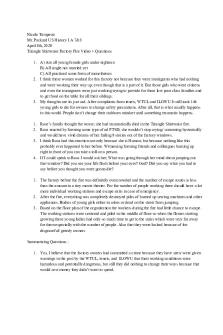Video Questions - Chelyabinsk Meteor PDF

| Title | Video Questions - Chelyabinsk Meteor |
|---|---|
| Course | Geography of Hazards |
| Institution | The University of Western Ontario |
| Pages | 2 |
| File Size | 79.9 KB |
| File Type | |
| Total Downloads | 21 |
| Total Views | 203 |
Summary
Video questions with answers ...
Description
GEOG 2152G: Geography of Hazards
Video: Chelyabinsk Meteor
1. What is infrasound? How does its analysis provide clues that a meteor may have exploded in the atmosphere? Infrasound – sound waves that are too low to hear. Deep base tones reflecting huge amounts of energy. Below level of human hearing. Clues - Can travel for a long time. Low frequency waves circled the world a few times from this blast. The stations with sensitive sensors that detected this were larger waves than ever seen before. 2. Describe the composition of a stony iron meteorite. How does this differentiate them from other meteorites in terms of weight? Stony iron- mixture of rock and metal. They have so much metal in them so they weigh more than other meteorites. So dense, the type of damage is incredible. They can survive in earth's atmosphere and leave fragments on Earth's surface. 3. In the laboratory, why are the scientists interested in learning about the density of the meteor? The Chelyabinsk meteor fragments were found to be 90% rock and 10% metal. What else did the microscope scans reveal about the meteor fragments? - Composition of asteroid is important for effects. (strength and density is important: a denser stronger one will fragment lower in the atmosphere where a weak one will fragment high in the atmosphere). -Revealed: interior untouched by the atmosphere Pressure can exceed the strength of the asteroid. Meteorite fragments have internal cracks (when hit atmosphere it was like hitting a brick wall and therefore exploded). The violent explosion caused the shockwave that spread out from that point that shattered windows etc.. in the city. 4. How is the angle of the meteor related to the intensity of the shockwave felt at Earth’s surface (i.e. which types of angles would create more intense shockwaves)? - The explosion happened about 15 miles above surface of earth. Shockwave ahead of it at a shallow angle. If the blast wave was focused downward (sharper angle) it would have been most disastrous (the sharper angle would have made it closer to the ground and taken out a whole city)
meteor with mostly metal would make a giant crater 5. What is NASA planning to do in order to discover more asteroids in the future? NASA: early warning – want to find the asteroids. Tracking of known asteroids and finding new ones. Focus on bigger ones. - Upgrade search capability. Deploy more effective technology (infrared telescope in space: would orbit around the sun and allow us to detect earlier with more accuracy). Will discover objects 140 meters in diameter. - Scan areas in space invisible from earth to survey sky of objects on collision courses. So you can see from the sun side as well....
Similar Free PDFs

Switch Video questions
- 4 Pages

Intersexion Video Questions
- 2 Pages

FDC video questions
- 2 Pages

OB Video Questions for Final
- 15 Pages

Video 2 Questions and responses
- 3 Pages

Video 1 questions new - bonus
- 1 Pages

Mt. St. Helens Video Questions
- 2 Pages

OB Video Questions for Midterm
- 4 Pages
Popular Institutions
- Tinajero National High School - Annex
- Politeknik Caltex Riau
- Yokohama City University
- SGT University
- University of Al-Qadisiyah
- Divine Word College of Vigan
- Techniek College Rotterdam
- Universidade de Santiago
- Universiti Teknologi MARA Cawangan Johor Kampus Pasir Gudang
- Poltekkes Kemenkes Yogyakarta
- Baguio City National High School
- Colegio san marcos
- preparatoria uno
- Centro de Bachillerato Tecnológico Industrial y de Servicios No. 107
- Dalian Maritime University
- Quang Trung Secondary School
- Colegio Tecnológico en Informática
- Corporación Regional de Educación Superior
- Grupo CEDVA
- Dar Al Uloom University
- Centro de Estudios Preuniversitarios de la Universidad Nacional de Ingeniería
- 上智大学
- Aakash International School, Nuna Majara
- San Felipe Neri Catholic School
- Kang Chiao International School - New Taipei City
- Misamis Occidental National High School
- Institución Educativa Escuela Normal Juan Ladrilleros
- Kolehiyo ng Pantukan
- Batanes State College
- Instituto Continental
- Sekolah Menengah Kejuruan Kesehatan Kaltara (Tarakan)
- Colegio de La Inmaculada Concepcion - Cebu







